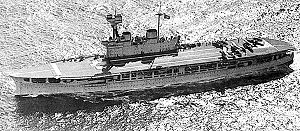HMS Eagle (1918)
 Eagle sometime in the 1930s
| |
| History | |
|---|---|
| Name | HMS Eagle |
| Builder | Armstrong Whitworth |
| Laid down | 20 February 1913 |
| Launched | 8 June 1918 |
| Commissioned | 26 February 1924 |
| Fate | Sunk by U-73 on 11 August 1942. |
| General characteristics | |
| Displacement | 22,200 tons (empty) |
| Length | 667 feet (203.3 m) |
| Beam | 92 feet (28 m) |
| Draught | 24 feet (7.3 m) |
| Speed | 24 knots |
| Range | 4,000 nm (7,400 km) at 18 knots |
| Complement | 834 officers and men |
| Armament | list error: <br /> list (help) 9 × 6 inch guns 12 × 20 mm Oerlikons 4 × 2 Pounder |
| Aircraft carried | 20 Hawker Sea Hurricanes |
HMS Eagle was an aircraft carrier of the Royal Navy sunk during World War II.
The Eagle was laid down at the Armstrong yards at Newcastle-on-Tyne on 20 February 1913. She was to be the battleship Almirante Cochrane for the Chilean Navy. Her construction was halted with the outbreak of World War I. In 1917 she was acquired for the Royal Navy, at a cost of £1.3 million, to be converted into the carrier HMS Eagle. She was the fourteenth ship to bear that name.
Her initial redesign was as a base for sea-plane operations. After trials with other ships the design was changed to a proper fleet carrier with a full flight deck and 'island'. She was launched on 8 June 1918 but the delays meant that the Eagle was unfinished at the end of hostilities. Construction was halted and not resumed until 1920 and she was only commissioned on 26 February 1924.
In September 1939 the Eagle was based at Singapore with an air-arm of eighteen Fairey Swordfish torpedo bombers. Her first offensive action of the war was as part of the hunt for the Admiral Graf Spee. She began 1940 in the Indian Ocean, but after repairs to explosion damage in March she joined the major units Malaya, Ramillies, Royal Sovereign and Warspite in the eastern Mediterranean at Alexandria in May.
Swordfish bombers from Eagle attacked the harbour at Tobruk on 5 July and sank an Italian destroyer and two merchantmen, a similar attack two weeks later (20 July) sank another two destroyers. On 9 July she was part of an ineffectual clash with the Italian fleet at Calabria, sometimes called the Battle of Punta Stilo.
On 22 August her aircraft attacked and sank an Italian submarine and a depot ship in the Gulf of Bomba. In September she joined the carrier HMS Illustrious as part of Operation Hats, and supported an attack on Maritza, Rhodes.
In mid-October she was part of the cover for a Malta convoy (MB-6). Her aircraft flew from Illustrious during the attack on Taranto (Operation Judgement, on 11 November), the damaged Eagle remained in Alexandria. On the 26th her aircraft attacked Tripoli.
In March 1941 she was assigned to Freetown. Her aircraft, flying from Port Sudan, attacked Italian ships at Massawa en route. She arrived at Freetown in early May, remaining there until October 1941.
She returned to Britain for a refit and rejoined the Mediterranean Fleet early in 1942. In February 1942 she carried aircraft for Malta, an operation repeated in May and twice in June. In June she also provided air cover for the convoy of Operation Harpoon (12th to 16th).
Her final action was in August 1942 as cover for the Malta-bound convoy of Operation Pedestal. On the early morning of 11 August she was hit by four torpedoes from U-73 of Helmut Rosenbaum and sank 70 nm south of Cape Salinas. The majority of the crew survived (927, only 160 lost) and were picked from the sea by her escorts.
